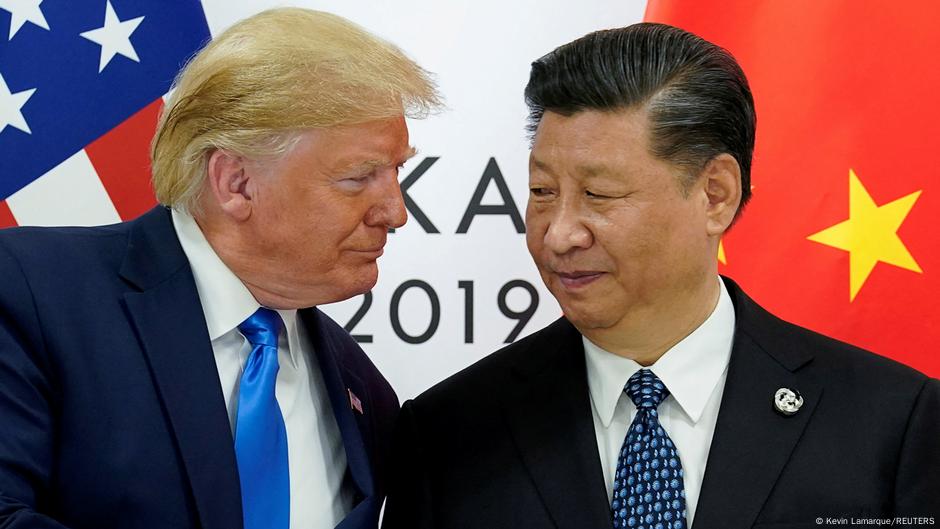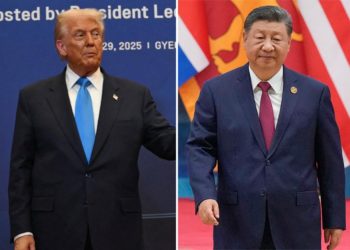The US and China have between Donald Trump and Xi Jinping, coming weeks after the two leaders traded blows in an escalating trade war.
In the run-up to the meeting, due Thursday on the sidelines of the Asia-Pacific Economic Cooperation summit (APEC), trade representatives from both sides said they’d hashed out a framework agreement involving lower US tariffs on Chinese imports and China delaying rare earth export curbs.
After arriving in South Korea on Wednesday, Trump said he expects a “l lot of problems” will be solved during the talks.
Trump shocked markets earlier this month after announcing 100% tariffs on Chinese imports, after China said it would restrict exports of rare earth minerals, which are essential to building high-tech goods.
The prospect of the leaders of the world’s two largest economies returning to the negotiating table has lifted stock markets across the globe this week.
Although details of the framework deal have not been made public, on Sunday, US Treasury Secretary Scott Bessent told US media outlets it would likely include “some kind of deferral” on Chinese rare earth mineral export controls and for China to buy a “substantial” amount of US soybeans.
Bessent also said that Trump’s threat of 100% tariffs was “effectively off the table.”
“Both sides seem to be making some concessions, which has made outsiders, especially investors, feel a bit more optimistic,” Dennis Weng, an associate professor of political science at Sam Houston State University, told DW.
However, Weng added that the truce now unfolding is unlikely to change “the fundamental dynamics of strategic rivalry” between Beijing and Washington in the long term.
“Everyone knows the competition is ongoing, but they don’t want it to suddenly trigger an economic collapse,” Weng said, adding that the goal for both countries is to allow the impact of their increasingly strained relations to “land softly.”
China has more leverage under Trump 2.0
The meeting in South Korea will be Trump’s first in-person encounter with Xi during his second term. The two leaders have spoken by phone at least three times this year, most recently in September.
Trump began his presidency by on countries around the world, but China was able to use its .
This has included halting purchases of US soybeans from the current harvest, which has cost US farmers billions.
Beijing threatening earlier this month was seen as a major escalation, as China mines some 70% of the global total, while controlling over 90% of refining capacity.
The developments have evoked a sense of deja vu, as Trump last met Xi in person during his first term in 2019 after launching the first trade war against China. But Beijing could be less willing to compromise this time around.
” feels a lot more confident. He’s probably willing to push his position a little bit more strongly,” Ja Ian Chong, an associate professor of political science at the National University of Singapore, told DW.
Weng also pointed out that “Beijing has studied Trump very thoroughly” to calculate its next move, with certain concessions strategically orchestrated in advance as bargaining chips.
“In fact, China stopped buying soybeans right after Trump took office in January, so it shows the whole soybean issue has been planned all along,” he said.
Will Xi press Trump on Taiwan?
Beyond trade disputes, Trump’s discussions with Xi are expected to cover over Taiwan, the self-ruling democracy that and has not ruled out using force to achieve “reunification.”
The US, while maintaining no formal diplomatic ties with Taiwan, remains the island’s main security backer and provider of military equipment and arms.
Ahead of the Trump-Xi meeting, concerns have mounted about a potential shift in the US support for Taiwan.
The Wall Street Journal first reported in September that Xi is renewing a push for the Trump administration to officially declare that it “opposes Taiwan independence.”
“It’s quite likely that [Trump] will make some comments related to Taiwan that Beijing considers harmless or non-provocative — Trump tends to go along with that,” analyst Weng said.
Amid the concerns, US State Secretary Marco Rubio said Saturday that the Trump administration will not abandon long-standing US support for Taiwan in negotiations with China to reach a trade agreement.
On Tuesday, Taiwanese Foreign Minister Lin Chia-lung said he was not worried that Trump would turn his back on Taiwan.
However, Weng told DW that Rubio’s statement is still vague, as the US approach to Taiwan “has always been quite flexible, with a wide range of options.”
This policy from the US is known as “strategic ambiguity.”
Any change in the decades-old US stance, phrased officially as “does not support Taiwan independence,” would be a major diplomatic win for Beijing and leave the island in a vulnerable position.
Analyst Chong believes it is less likely to be a major shift in US rhetoric on Taiwan, given the island’s strategic location in the Indo-Pacific, as the change “would also entail a major shift across the [Indo-Pacific] region.”
What is next for US-China relations?
arrived in South Korea on Wednesday but is set to leave the next day, skipping the main agenda of the APEC summit.
He reportedly told a room full of CEOs at the summit that he believes the US is “going to have a deal” with China and it will be “a good deal for both.”
Previously, Trump also said he plans to visit early next year, without providing a specific timeline.
Weng expects the period from the upcoming talks to Trump’s visit to China will be one of relative easing in tensions between the two sides.
But Chong cautions that while the Trump-Xi summit provides a window for signals, “what happens after the meetings is no less important.”
“The thing to remember is that for both the US and the PRC [China], they are quite willing and from any agreement they make.”
Edited by: Wesley Rahn
The post What to expect as Trump and Xi meet in South Korea appeared first on Deutsche Welle.




